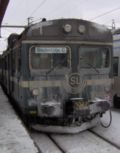| X1 | |
|---|---|
 X1 at Årstaberg station | |
 | |
| In service | 1968–2011 |
| Manufacturer | ASEA, Kalmar Verkstad, ASJ |
| Constructed | 1967–1975 |
| Entered service | 1968–2011 |
| Scrapped | 2004–2011 |
| Number built | 104 |
| Number scrapped | 103 |
| Capacity | 196 |
| Operators | Storstockholms Lokaltrafik Citypendeln Stockholmståg MTR Nordic |
| Lines served | Stockholm commuter rail |
| Specifications | |
| Train length | 49.55 m (162 ft 7 in) (2 cars) |
| Width | 3,150 mm (124 in) |
| Platform height | 760 mm |
| Maximum speed | 222 km/h (138 mph) (albeit affectively 120 km/h (75 mph)) |
| Weight | 78 t (76.8 long tons; 86.0 short tons) |
| Power output | 1,120 kW (1,500 hp) |
| Electric system(s) | 15 kV 16.7 Hz AC catenary |
| Current collection | Pantograph |
| Braking system(s) | disk brakes |
| Track gauge | 1,435 mm (4 ft 8+1⁄2 in) |
| Notes/references | |
| 2 cars fleet numbers 3001-3004 | |
X1 was a series of two-car electric multiple units (twin units) owned by Greater Stockholm Transport (SL) on the Stockholm commuter rail. The X1 was operated in sets of up to five units, making ten-car trains, each unit consisting of one motor car and one unpowered car. 104 units were built by ASEA in 1967–75 and were replaced by the new X60. The X1 also served as the foundation for the later X10–X14 series trains, built in the 1980s and 1990s.


